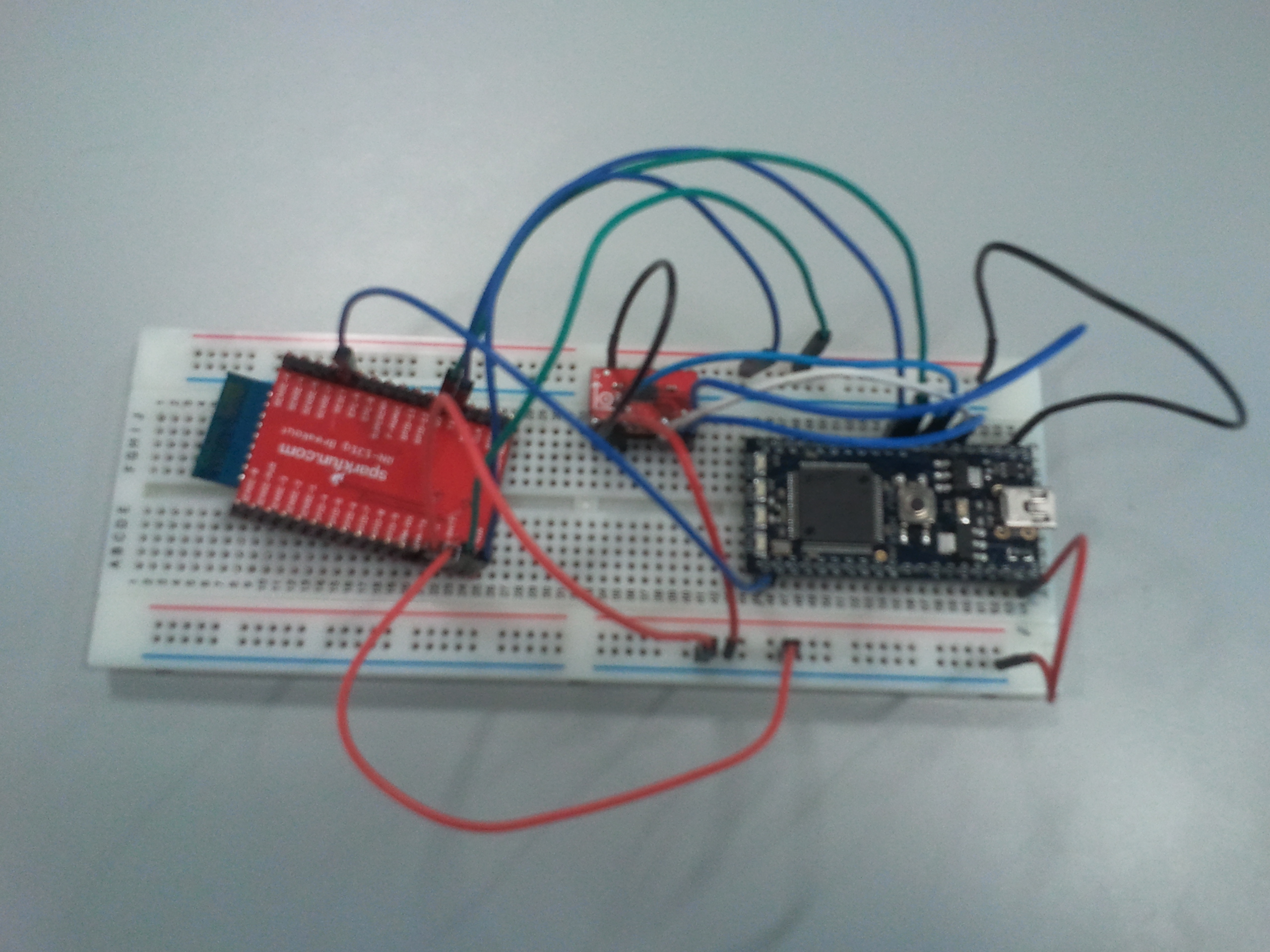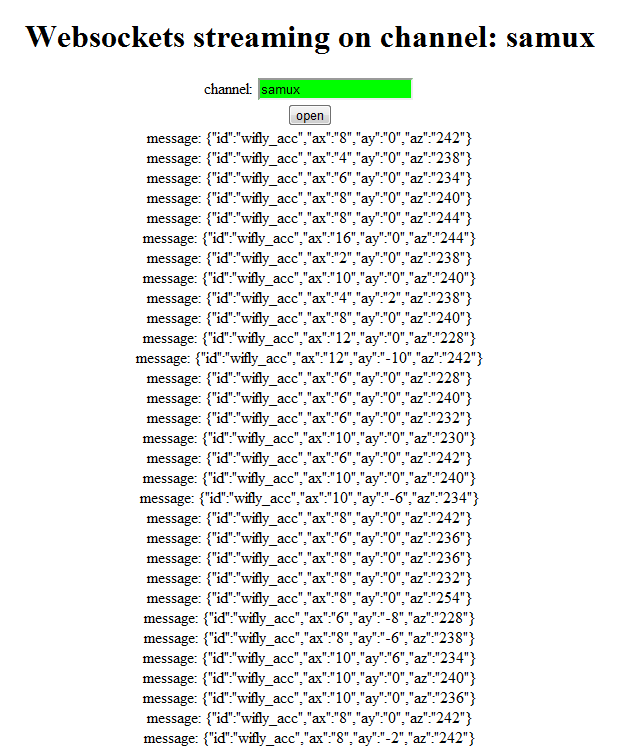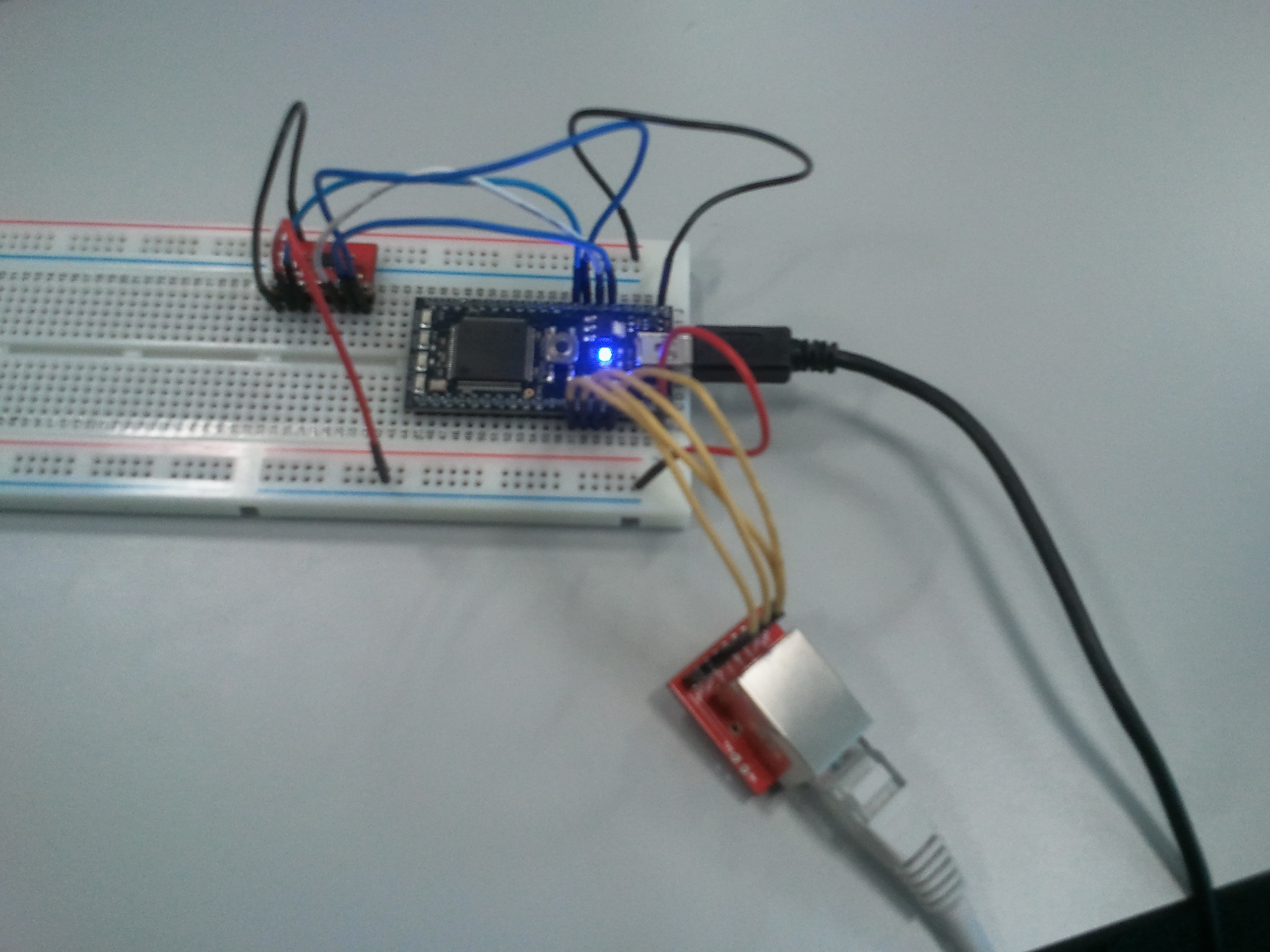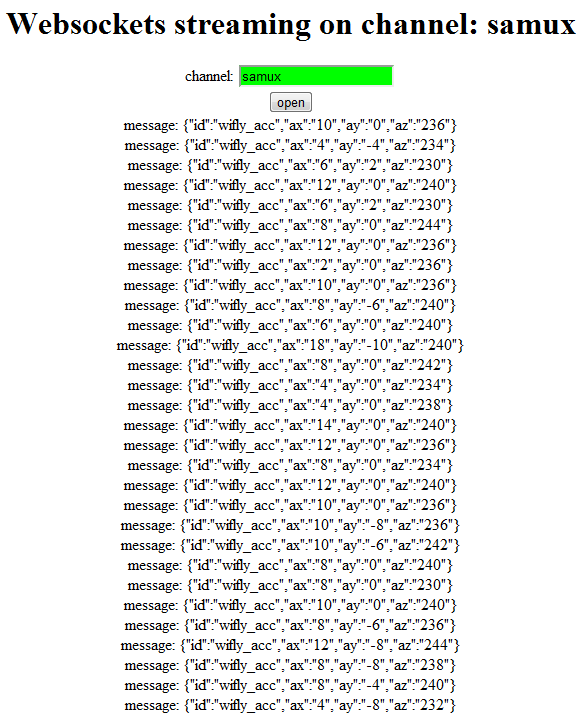You are viewing an older revision! See the latest version
Websocket and Mbed
Websockets and Mbed¶
As explained in this webpage(!), the Websocket protocol allows full-duplex, bi-directional communications between a server and clients.
-> In this tutorial, the websocket server already exists (at ARM).
-> So you just have to program your mbed
If you want more information regarding the server side code, go to this webpage
This tutorial is divided into two parts:
- Sending accelerometer data over a websocket, from an mbed:
- first, over wifi
- then using an ethernet connection
- Display this data using a
(new feature of HTML5)
1 - Send accelerometer data from the mbed¶
1.1 - Protocol used by the server¶
The url format to establish a connection with the server is: ws://89.16.167.192:444/mbed-demo/<mode>/<channel>
The websockets are divided into channels.
When the server receives a message from a client in a certain channel:
- it will broadcast the message to all clients connected to this channel who are not in 'w' mode
- A client in 'w' mode connected to this channel can only 'write' (send) messages to this channel. It cannot receive messages
- A client in a mode other than 'w' can send and receive messages over the channel
1.2 - Javascript part¶
This code is very similar to the one presented in second part of this tutorial.
Take note!
We present this code for you to modify as you wish, but if you want to just go to our website to see the webpage, you can skip this section, and visit / instead.
<!doctype html>
<html>
<head>
<style type="text/css">
body {
text-align: center;
min-width: 500px;
}
</style>
<script src="http://code.jquery.com/jquery.min.js"></script>
<script>
function log(m) {
d = document.getElementById("log");
d.innerHTML = m + "<br/>" + d.innerHTML;
}
$(document).ready(function () {
$("#open").click(function(evt) {
evt.preventDefault();
var channel = $("#channel").val();
var ws = new WebSocket("ws://89.16.167.192:444/mbed_demo/rw/" + $("#channel").val());
ws.onopen = function(evt) {
$("#channel").css("background", "#00ff00");
document.getElementById("title").innerHTML = "Websockets streaming on channel: " + $("#channel").val();
};
ws.onmessage = function(evt) { log("message: " + evt.data); };
ws.onclose = function(evt) { log("socket closed"); };
});
});
</script>
</head>
<body>
<h1 id="title">Websockets Streaming</h1>
<label for="channel">channel:</label>
<input type="text" id="channel" style="background:#ff0000;"/><br />
<input type="submit" id="open" value="open" />
<div id="log"></div>
</body>
</html>
On this webpage, you must associate your connection with a 'channel'. In this example, I will use the channel samux, but I could use anything. So I fill in the channel field and press open
If the connection is established:
- we change the background of the channel field from red to green
- we change the title according to the channel
When a message is received: - we print the message received below


So the websocket is opened, now the Mbed part!
1.3 - Sending data from the Mbed: Wifi¶
Materials required
For this part you need:
- an mbed ;)
- a Wifly module like this
- a router
- sensor(s) (for this tutorial, I will use this accelerometer)
1.3.1 - Schematics:


1.3.2 - Code:
Libraries required
For this part you need to import these libraries:
- Websocket
- Wifly
- EthernetIf. You must import the program as a library
- DNSResolver
- For the sensor: ADXL345
The main code:
#include "mbed.h"
#include "Wifly.h"
#include "Websocket.h"
#include "ADXL345.h"
Serial pc(USBTX, USBRX);
ADXL345 accelerometer(p5, p6, p7, p8);
Wifly * wifly;
Websocket * ws;
int main() {
char json_str[100];
wifly = new Wifly(p9, p10, p21, "NETGEAR", "bananna2", true);
//Here, we create an instance, with pins 9 and 10 connecting to the WiFly's TX and RX pins, and pin 21 to GPIO 6. We are connecting to the NETGEAR network, password bananna2, and we are using WPA.
ws = new Websocket("ws://89.16.167.192:444/mbed_demo/w/samux", wifly);
pc.printf("\x1B[2J");
pc.printf("\x1B[H");
pc.printf("Tuto Websocket Mbed!\r\n");
int readings[3] = {0, 0, 0};
pc.printf("Starting ADXL345 test...\r\n");
pc.printf("Device ID is: 0x%02x\r\n", accelerometer.getDevId());
//Go into standby mode to configure the device.
accelerometer.setPowerControl(0x00);
//Full resolution, +/-16g, 4mg/LSB.
accelerometer.setDataFormatControl(0x0B);
//3.2kHz data rate.
accelerometer.setDataRate(ADXL345_3200HZ);
//Measurement mode.
accelerometer.setPowerControl(0x08);
while (1) {
while (1) {
while (!wifly->Join())
wifly->reset();
if (!ws->connect())
wifly->reset();
else
break;
}
while (1) {
wait(0.1);
//we read accelerometers values
accelerometer.getOutput(readings);
sprintf(json_str, "{\"id\":\"wifly_acc\",\"ax\":\"%d\",\"ay\":\"%d\",\"az\":\"%d\"}", (int16_t)readings[0], (int16_t)readings[1], (int16_t)readings[2]);
ws->Send(json_str);
}
}
}
This code is very simple:
- accelerometers initialization
- connection to the router
- connection to the websocket server
- send data from accelerometers in a JSON string each 0.01s
1.3.3 - Demo:

Et Voila! We are able to see on our webpage the data from accelerometers over a wifi network!
1.4 - Sending data from the Mbed: Ethernet¶
Materiel required
For this part you need:
- an Mbed ;)
- an Ethernet RJ45 jack
- a router
- a sensor (for this tutorial, I will use this accelerometer)
1.4.1 - Schematics:

1.3.2 - Code:
Library required
For this part you need to import these libraries:
- Websocket
- EthernetIf. You must import the program as a library
- DNSResolver
- For the sensor: ADXL345
The main code:
#include "mbed.h"
#include "Websocket.h"
#include "ADXL345.h"
#define MEAN_LENGTH 2
Serial pc(USBTX, USBRX);
ADXL345 accelerometer(p5, p6, p7, p8);
Websocket * ws;
int main() {
char json_str[100];
ws = new Websocket("ws://89.16.167.192:444/mbed_demo/w/samux");
pc.printf("\x1B[2J");
pc.printf("\x1B[H");
pc.printf("Tuto Websocket Mbed!\r\n");
int readings[3] = {0, 0, 0};
pc.printf("Starting ADXL345 test...\r\n");
pc.printf("Device ID is: 0x%02x\r\n", accelerometer.getDevId());
//Go into standby mode to configure the device.
accelerometer.setPowerControl(0x00);
//Full resolution, +/-16g, 4mg/LSB.
accelerometer.setDataFormatControl(0x0B);
//3.2kHz data rate.
accelerometer.setDataRate(ADXL345_3200HZ);
//Measurement mode.
accelerometer.setPowerControl(0x08);
while (1) {
while(!ws->connect())
pc.printf("cannot connect webasocekt\r\n");
while (1) {
wait(0.1);
//we read accelerometers values
accelerometer.getOutput(readings);
sprintf(json_str, "{\"id\":\"wifly_acc\",\"ax\":\"%d\",\"ay\":\"%d\",\"az\":\"%d\"}", (int16_t)readings[0], (int16_t)readings[1], (int16_t)readings[2]);
ws->Send(json_str);
}
}
}
This code is another time very simple:
- accelerometers initialization
- connection to the websocket server
- send data from accelerometers in a JSON string each 0.01s
Note that the websocket API is the same if you are using a wifi module or an ethernet connection
1.4.3 - Demo:

Et Voila! We are able to see on our webpage the data from accelerometers over an ethernet network!